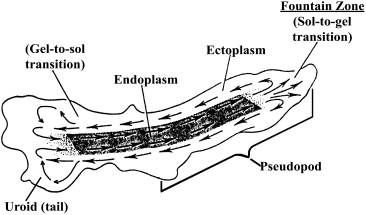Preface | Introduction to Problem Solving | Problem Sets | Acknowledgments
| E.1. Amoeboid Locomotion Next Problem>> | |
(28 pts) Amoeba proteus, a single-celled eukaryote, moves by means of
psudopods attaching to and detaching from the substratum. Locomotion seems
to be correlated with the forward flow of fluid cytoplasm (endoplasm)
into an advancing pseudopod through a surrounding, gel-like ectoplasmic
tube. The ectoplasm forms at the pseudopodial tip in a region called the
Fountain Zone. As the amoeba advances the ectoplasmic tube “liquifies”
at the posterior end to form endoplasm. These features are illustrated
in the figure below.
 |
Both locomotion and cytoplasmic streaming
are inhibited by cytochalasin B.
Consider everything you’ve learned so far and answer all the following questions. |
A. (4 pts) When amoeba undergoes cell division, it stops streaming and
rounds up into a
spherical cell. Describe how this change in shape and behavior comes about
and why it
might be a necessary precondition for division.
(6 pts) Briefly describe how cytoplasmic streaming is most likely organized
and generated
at the cellular and molecular levels. Use a diagram to illustrate your
description.
B. (5 pts) Briefly describe an additional experiment or observation that
would test your
hypothesis and indicate clearly what the results would show.
C. (8 pts) Describe clearly, with the aid of a well-labeled diagram, how
streaming within
a pseudopod could result in movement of the amoeba across the substratum.
D. (5 pts) Describe how your streaming mechanism might be regulated such
that the
amoeba might change its streaming pattern to form phagocytic pseudopods
around a
ciliate it had touched.
Now evaluate some past answers to these questions, in light of your own
essays. Note
that better answers contain more information that you are now able to
synthesize, at
this point in the course. On the other hand, you may now know more about
the various
mechanisms than the students who answered these questions in the mid ‘90’s
did!
A. (4 pts) When amoeba undergoes cell division, it stops streaming and
rounds up
into a spherical cell. Describe how this change in shape and behavior
comes about
and why it might be a necessary precondition for division.
|
Answer
|
Comments
|
| Example 1. In order for the single cell to divide it must become a shape that is] spherical enough for the spindle to form] and an even distribution of cytoplasmic] material to take place when cytokinesis] happens. Also, cytokinesis cannot take] place with a firm gel-like tube in the middle] of the cell. In order for cell division to] occur, the gel-like tube will dissolve into all] endoplasm which is a liquid form. The] cytoskeleton will form as a normal] eukaryotic cell and cytokinesis will divide] the cell. Once the cell has full divided, the] endoplasm will form a new ectoplasm tube] again and all will continue | A good start, but more mechanistic detail
is required: what sorts of cytoskeletal elements are involved? Wordy! Simply restates information> provided. “normal” means what? |
| Contrast the first answer with the following: | |
| Example 2. Microfilaments are needed for cytokinesis. They form a “belt” perpendicular to the spindle fibers needed for mitosis. This belt contracts, pinching off the cytoplasm from the original cell into 2 daughter cells. Microfilaments are dynamic structures, and those which previously were involved in streaming or maintaining cell shape are disassembled and used for cell division. When this occurs, the cell assumes a natural round shape and all streaming stops due to lack of microfilaments which would turn the endoplasm into ectoplasm. | A focused, mechanistic answer from the start! Connection with streaming established; dynamic properties identified. A problem: what is “natural?” |